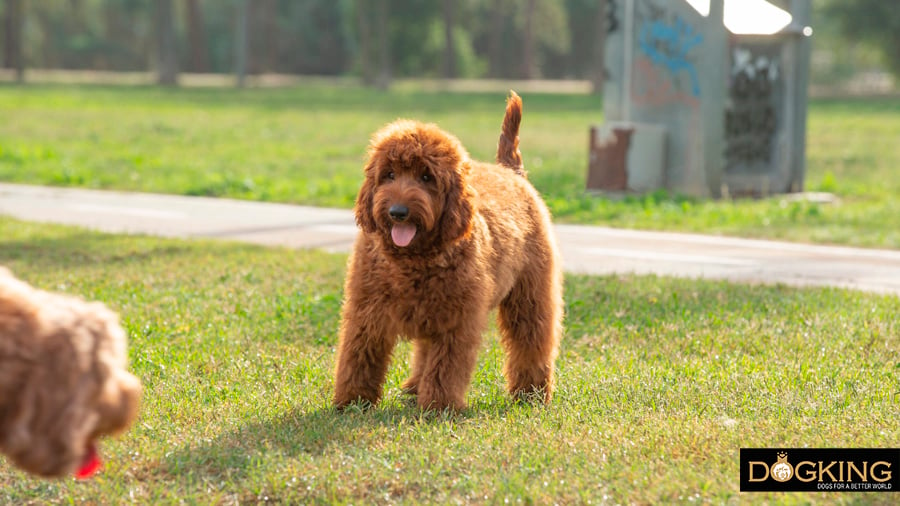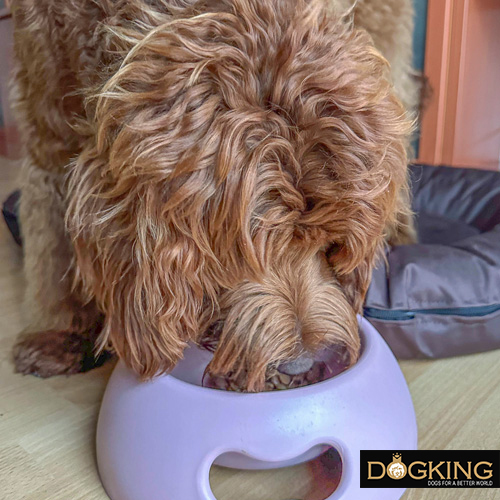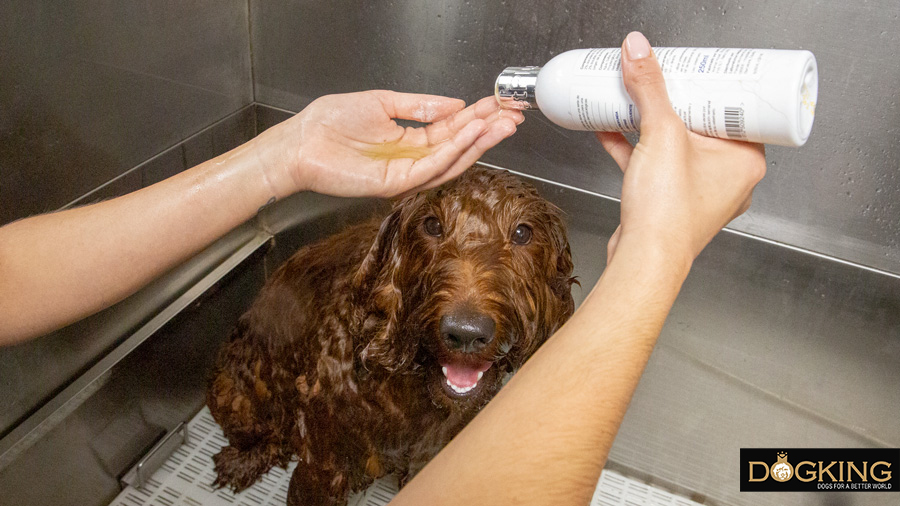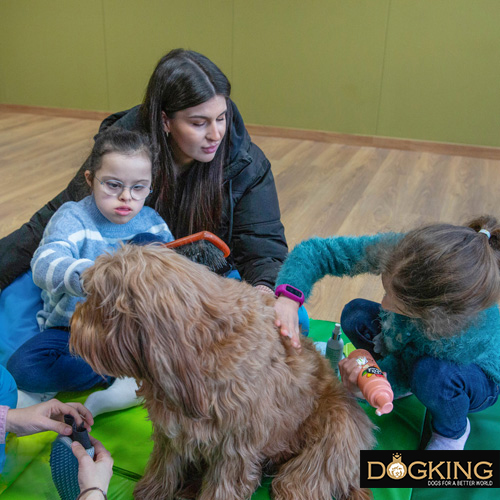Wie Sie den Glanz und die Gesundheit Ihres Hundes verbessern können
Was Sie über die Fellpflege Ihres Hundes wissen müssen

WIE SIE DEN GLANZ UND DIE GESUNDHEIT DES HUNDEFELLS VERBESSERN KÖNNEN
Ungefähre Lesedauer: 7 minuten
Wenn Sie Ihren Hund so betreuen, wie er es verdient, sollten Sie sich auch um die Bedürfnisse seines Fells pflegen. Das lässt ihn nicht nur gut aussehen, sondern hilft auch, größere Gesundheitsprobleme seiner Haut zu vermeiden, ihn an hygienische Gewohnheiten zu gewöhnen und die Bindung zwischen ihnen beiden zu verbessern.
Im folgenden Artikel erfahren Sie, wie Sie das Fell Ihres Hundes glänzend und vor allem gesund halten können.

Inhaltsübersicht
1- Voraussetzungen für ein gesundes, glänzendes Fell
2- Die Bedeutung der Haarpflege bei Hunden
3- Was ist, wenn mein Hund noch ein Welpe ist?
Voraussetzungen für ein gesundes und glänzendes Fell
Hochwertiges Futter
 Die Art und Weise, wie man sich innerlich pflegt, spiegelt sich auch in der äußeren Erscheinung wider, auch bei Hunden. Wenn die Ernährung Ihres Haustieres nährstoffarm ist, ist sein Fell wahrscheinlich trocken, stumpf und neigt zu Haarausfall. Um dies zu vermeiden, sollte die Ernährung reich an Fettsäuren, Salzen, Zink, Jod, den Vitaminen A, B, C und E, Omega 3 und Omega 6 sein. Lebensmittel wie Sardinen, Lachs, Karotten und Eigelb werden von Experten sehr empfohlen und sind meist in hochwertigem Tierfutter zu finden. Dennoch ist es immer ratsam, den Tierarzt zu fragen, um den individuellen Bedürfnissen jedes Hundes besser gerecht zu werden und bei Bedarf Vitaminpräparate zu geben.
Die Art und Weise, wie man sich innerlich pflegt, spiegelt sich auch in der äußeren Erscheinung wider, auch bei Hunden. Wenn die Ernährung Ihres Haustieres nährstoffarm ist, ist sein Fell wahrscheinlich trocken, stumpf und neigt zu Haarausfall. Um dies zu vermeiden, sollte die Ernährung reich an Fettsäuren, Salzen, Zink, Jod, den Vitaminen A, B, C und E, Omega 3 und Omega 6 sein. Lebensmittel wie Sardinen, Lachs, Karotten und Eigelb werden von Experten sehr empfohlen und sind meist in hochwertigem Tierfutter zu finden. Dennoch ist es immer ratsam, den Tierarzt zu fragen, um den individuellen Bedürfnissen jedes Hundes besser gerecht zu werden und bei Bedarf Vitaminpräparate zu geben.
Regelmäßiges Bürsten und Trimmen
Damit das neue Haar von guter Qualität ist und gesund wachsen kann, muss die Haut belüftet und gut durchblutet werden, was vor allem durch Bürsten und Trimmen erreicht wird.
Wie oft wir unseren Hund bürsten sollten, variiert zwischen einem Mal und sieben Mal pro Woche und hängt hauptsächlich von zwei Faktoren ab: der Rasse und der Länge des Haares. Langhaarige Hunde müssen mindestens einmal pro Tag gebürstet werden, da sie besonders nach einem Spaziergang stärker zum Verknoten neigen. Ein gut gebürstetes Fell ist das Gegenteil von einem verknoteten Fell, dem es an Atmungsaktivität mangelt, d. h. bei dem man die Haut des Hundes nicht sehen kann, wenn man sie mit den Händen versucht zu öffnen. Um Verknotungen zu vermeiden, sollte das Fell in mehreren Schichten gebürstet und alle Knoten mit den Fingern oder einem Metallkamm entfernt werden, wenn sie sich nicht so leicht auflösen lassen. Stecken Sie die Spitze des Kammes in die Wurzel des Knoten und ziehen Sie ihn allmählich nach außen, indem Sie ihn gegebenenfalls mit den Fingern öffnen.Auf diese Weise muss das Haar nicht geschnitten werden, der Schmutz wird entfernt und das Haar erhält ein glänzendes Aussehen. Es sollte auch darauf geachtet werden, dass die Art des verwendeten Werkzeugs besondere Aufmerksamkeit benutzt werden sollte, da eine Bürste nicht für alle Hunde gleichermaßen wirksam ist. Für kleine Hunde oder solche mit brüchigem oder lockigem Haar ist es besser, einen Kamm mit runder Spitze zu verwenden, während es für größere Hunde mit glattem Haar bequemer ist, einen Karder zu benutzen, wie wir Ihnen im folgenden Video zeigen
Was den Haarschnitt anbelangt, so empfiehlt sich vor allem bei längerem Fell ein monatlicher Besuch beim Hundefrisör, um ein glänzendes und gesundes Fell zu erhalten.
Andererseits und trotz der Tatsache, dass kurzes Haar leichter zu bändigen zu sein scheint oder nicht so oft gebürstet werden muss, kann es, da es oft dicker ist, bestimmte Auffälligkeiten in der Haut unseres Hundes wie Beulen, Parasiten oder Wunden verbergen, die besondere Aufmerksamkeit erfordern. Außerdem ist zu beachten, dass alle Arten von Fell schmutzig werden, indem sie Staub ansammeln und schlechte Gerüche aufnehmen. Aus all diesen Gründen ist es wichtig, dass Hygieneregelungen regelmäßig durchgeführt werden, unabhängig von der Länge oder Art des Fells.
Spezielle Pflegeprodukte
Einer der größten Fehler bei der Pflege von Hundehaaren ist die Verwendung von Produkten für Menschen, seien es Shampoos oder Duschgels. Sie sind nicht nur aggressiv für das Fell, sondern auch für die Gesundheit der Haut und können Reizungen oder sogar schwere Verletzungen verursachen. Daher sollten wir immer Shampoos für Hunde wählen, die möglichst auf den jeweiligen Haartyp, das Alter, die Farbe, die Länge usw. abgestimmt sind.
Es gibt auch funktionelle Shampoos, z. B. hypoallergene Shampoos, Shampoos gegen Haarausfall, pflegende Shampoos, Shampoos gegen Schuppen und Shampoos gegen Parasiten, um die Gesundheit des Haares und die individuelle Gesundheit Ihres Hundes zu gewährleisten. Es ist nicht immer möglich, neutrale Shampoos mit allgemeingültigen Formeln zu verwenden, sondern wir müssen uns auf den Haut- und Haartyp einstellen, den unser Haustier benötigt.
Um zusätzlichen Glanz und Feuchtigkeit zu bieten, können wir beim Bürsten auch Parfüms mit Öl verwenden und beim Baden Balsame, die sowohl die Haut als auch das Fell nach dem Auftragen des Shampoos beim Baden nähren.

Reinigungsroutinen
Was das Baden betrifft, so gibt es keine bestimmte Anzahl von Waschgängen, die über den bereits erwähnten monatlichen Besuch beim Hundefriseur hinaus eingehalten werden sollten, sondern alles hängt vom Pflegestil des Hundes ab. Dies hängt jedoch von der Lebensweise und den spezifischen Bedürfnissen des jeweiligen Hundes ab. Wenn es sich beispielsweise um einen Welpen handelt, der noch lernt, sich hygienisch zu erleichtern, oder um einen Hund, der täglich übel riechenden oder schmutzigen Elementen ausgesetzt ist, kann eine höhere Anzahl von Waschungen und Reinigungen brauchen und es ist immer notwendig, den Friseur für die erste individuelle Behandlung zu fragen. Wenn der Hund im Haus lebt, zusätzlich von Kindern oder Personen in schlechtem Gesundheitszustand, und wie es bei unseren Therapiehunden der Fall ist, wäre Platz für wöchentliche Bäder. In diesem Fall sollten wir jedoch unseren Hundefriseur bitten, uns ein Shampoo zu empfehlen, das den PH-Wert des Hundes nicht angreift.
Außerdem ist es wichtig, dass der Hund vor und nach dem Baden gebürstet wird, aber immer trocken. Es ist sehr wichtig, den Schritt des Bürstens nicht auszulassen, da sich das Shampoo so besser im Fell verteilen kann, es keine Verstrickungen gibt und eventuelle Knoten vorher entwirrt werden, damit sie sich nicht weiter schließen. Das Bürsten mit noch nassem Fell würde das Lösen der Knoten erschweren, was für unseren Hund gar nicht gefällt oder sogar schmerzhaft sein könnte.
Wenn Ihr Hund lange Haare hat, sollten Sie noch auf ein weiteres Detail achten: seine Ohren. Auch sie neigen dazu, in diesem Bereich Haare anzusammeln, als Abwehrmechanismus gegen mögliche Fremdkörper, die in das Innere der Ohren eindringen könnten. Dieses Fell kann zu mehr Ohrenschmalz, Schmutz oder unzureichender Schweißabsonderung in den Ohren führen, so dass auch diese häufig gereinigt werden sollten.
Die Bedeutung der Haarpflege bei Hunden
 Die tägliche Haarpflege ist nicht nur für Menschen wichtig, sondern auch für unsere Hunde. Auf diese Weise können wir nicht nur Schmutz, schlechten Geruch, Verstrickungen und mögliche Parasiten vermeiden, die ihre Gesundheit bedrohen können, sondern diese Routine ist eine Zeit, die nur einzig und allein ihnen gewidmet ist und die die Beziehung zwischen ihnen stärken wird. Besonders bei Hunden wie Australian Cobberdogs sind Ihre Zeit und Aufmerksamkeit eine der besten Belohnungen, die Sie ihnen geben können. In der Tat ist das Bürsten eine der Aktivitäten, die wir in unseren tiergestützten Therapien durchführen und die sich dadurch auszeichnen, dass sich die Stimmung von Kindern mit Bedürfnissen jenseits des Haarzustandes des Hundes verbessern.
Die tägliche Haarpflege ist nicht nur für Menschen wichtig, sondern auch für unsere Hunde. Auf diese Weise können wir nicht nur Schmutz, schlechten Geruch, Verstrickungen und mögliche Parasiten vermeiden, die ihre Gesundheit bedrohen können, sondern diese Routine ist eine Zeit, die nur einzig und allein ihnen gewidmet ist und die die Beziehung zwischen ihnen stärken wird. Besonders bei Hunden wie Australian Cobberdogs sind Ihre Zeit und Aufmerksamkeit eine der besten Belohnungen, die Sie ihnen geben können. In der Tat ist das Bürsten eine der Aktivitäten, die wir in unseren tiergestützten Therapien durchführen und die sich dadurch auszeichnen, dass sich die Stimmung von Kindern mit Bedürfnissen jenseits des Haarzustandes des Hundes verbessern.
Was ist, wenn mein Hund noch ein Welpe ist?
Von klein auf ist es wichtig, die Sozialisierungsphase zu nutzen, um unsere pelzigen Freunde an die richtige Hygiene zu gewöhnen. Der Kontakt mit Wasser, dem Waschhandschuh, der Bürste oder dem Fön sind einige der Elemente, die jeder Hund mit positiven Erfahrungen verbinden sollte, vor allem in einer Phase, die voller erster Male ist. Bei DOGKING stellen wir zum Beispiel sicher, dass der Welpe, den jede Familie bekommt, das Baden bereits in seinen Lernprozess integriert hat. Und abgesehen von der Verwendung der besten Produkte wird die Tatsache, dass Ihr Hund nicht an diese Routine gewöhnt ist oder sie nicht verinnerlicht hat, es Ihnen und ihm wahrscheinlich schwer machen, seine Pflege durchzuführen.
Um eine optimale Pflege des Australian Cobberdogs zu gewährleisten, ist es wichtig, zwischen den Pflegeutensilien für einen erwachsenen Hund und denen für Welpen zu unterscheiden. Da die Haare eines Welpen kürzer und noch feiner sind, benötigen sie weniger Kraft und Hitze, wenn man einen Föhn oder einen Ejektor verwendet. In dieser ersten Phase sollten Sie einen Metallkamm und einen Kamm mit geschützter Spitze verwenden, um die empfindliche Haut des Welpen nicht zu verletzen. Wenn das Haar des Welpen wächst (ca. 5-6 Monate), müssen Sie es in mehreren Schichten bürsten, um Verstrickungen der inneren Schichten zu vermeiden. Im folgenden Video erklären wir Ihnen alles im Detail:
Trotz all dieser Hinweise ist es immer ratsam, einen Kurs bei unserem Friseur zu besuchen, damit er uns die Schritte, Werkzeuge und Produktempfehlungen, die für unseren Hund in jeder Phase am besten geeignet sind, im Detail erklären kann.